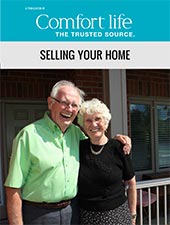What to know about this topic:

Bob and Diane were happily aging in place in their urban community. But then circumstances changed, and Diane fell ill after hip surgery. She required support with the help of home care services. Even then, change still found its way into their lives.
Diane’s recovery was surprisingly slow and a second operation was scheduled. Her hip pain prevented her from driving, so she relied on taxis and Uber to get to appointments, and she missed her workouts and coffee dates with friends. Meanwhile, Bob continued with his activities, but worried about the rapid and drastic changes in his wife’s wellbeing and her increasing depression.
When Diane was having her second hip replacement surgery, Bob had an attack of iritis with serious consequences. At home alone, doing laundry at 11pm, he misjudged his steps and fell down the basement stairs, where he lay on the floor for ten hours –his cell phone was upstairs on the kitchen counter. When the cleaning lady arrived at 9 am, he was in terrible pain from a broken right femur, and very badly shaken. ‘Within a few hours, I turned into a frightened old man,’ he said later.
Diane had arranged for a month-long post-operative respite stay at a retirement residence. Now Bob, on crutches, unable to see well or drive, and apprehensive about going home alone, decided to join her.
Bob expected ‘death’s waiting room with Bingo’, but Diane had done her research and selected a retirement community with a full spectrum of support, from independent living to full care. The community included a medical office, programming and lectures, a wellness centre with personal trainers, flexible dining hours, menus and seating arrangements, guest suites for visitors… and yes, sometimes, Bingo. The wellness centre staff also delivered physiotherapy, saving both Bob and Diane trips to their old clinic downtown. Medication was ordered, managed and delivered by the nursing staff, personal care was available on an as-needed basis, as was a more extensive care package for Diane, through private care. ‘Why exactly are we going back to the house?’ she soon began to wonder.
True to their cohort, once again, Bob and Diane objectively appreciated the retirement community for how it addressed their immediate and future needs. Instead of being ‘a place where Grandma had to go’ (as was feared by the older generation, exemplified by Graham and Ethel), they appreciated the convenience of the amenities, the opportunities for socialization, for aging in place, and the overall peace of mind for themselves and their adult children.
Learning that ‘life-lease’ condos were available in the retirement complex, Bob and Diane remained in their suite until a two-bedroom unit became available. Priced at a reasonable $500,000 with a monthly maintenance fee of $300, their new condo was spacious, and custom-designed for accessibility. Being a life-lease means that, when they want to move from the unit, it must be sold back to the retirement complex at the current market price, with the appreciation in price being theirs to keep. The sale of their home and its related expenses left them with funds to renovate the unit and gift some funds to their two children. They both gave up their cars but continued to go to restaurants and theatres and visit friends using public transit, transportation provided by the community, and Uber.
Their budget in the retirement community
| ITEM | MONTHLY COST |
| life-lease condo fee | $300.00 |
| care and support package – Diane | $1,200.00 |
| support for Bob - as-needed, 4 visits @$25/hour | $100.00 |
| daily dinner package x 2 | $1,200.00 |
| groceries for breakfast and lunch | $150.00 |
| internet, 2 cell phones | $100.00 |
| Drugstores | $200.00 |
| Liquor | $100.00 |
| Entertainment - dining, theatre | $250.00 |
| Clothing | $50.00 |
| Sundry cash | $500.00 |
| Uber - visits, appointments - for both | $200.00 |
| travel - 1 trip/year to visit grandkids in Vancouver | $300.00 |
| TOTAL MONTHLY COST | $4,650.00 |
Gone are the house and car expenses; groceries for breakfast and lunch are minimal, and dinner is purchased from the retirement home dining room. Now that they’re receiving support, Bob and Diane feel well enough to revive restaurant outings, and an annual trip west, to see the grandkids
Once again Bob and Diane’s behaviour is typical of their cohort. The concept of life-lease did not exist previously. Bob and Diane were able to recognize this added option as an investment in their future well being, but they also defied it stereotyping them. The retirement community is where they live, but if doesn’t define them as old or ill. Theirs was a decision based on lifestyle, not age.
Should their needs change, and the retirement home is not able to provide the exact care they need, they know they are able to hire in private home care services as an augmentation. This, too, is a product of their assumption of self-empowerment and independence.
Summing up
The baby boom demographic definitely has its own ideas about life! Their cohort is lucky enough to have the resources, education and range of options to make informed choices for their futures. As more baby boomers age, they will continue to alter the financial landscape, and add many more options offered by senior care providers of all kinds.
Read more
- Aging in place: Bob and Diane, 2017
- Aging in place with community support, with the help of a home care agency.
Our previous look at aging at home
- Aging at Home is Free, Right?
- Aging at Home with Community Support
- Aging at Home with Agency Care
- Aging at Home with Live-in Care
- Aging in Place vs. Moving into a Retirement Home



